- Hybrid work is a flexible solution to maximize productivity and balance home life with work. But is it the most effective work model for tech talent? Insights from the Digital Leadership Report hint at many advantages, albeit not without some challenges.
- The hybrid model offers flexibility, reduces commute times, and can boost productivity for developers who get to work without distractions. Tech companies with hybrid models also hire more women and can reach beyond major tech hubs to access a bigger talent pool, remotely.
- But working hybridly can also create a work-life imbalance and affect chances of promotions. Tech professionals might struggle with mental wellness and be unable to collaborate effectively over remote networking tools.
- How tech companies address these challenges will affect the adoption of the hybrid setup across technology jobs in the future.
The hybrid workplace model has been hailed as the future of work, blending remote and in-office setups to create a unique solution, particularly in the tech industry. It promises flexibility, work-life balance, and access to global talent unfettered by time and space constraints—what’s not to love? On the surface, hybrid work seems to check all the boxes, and this has tech companies embracing it left, right, and center.
But is it really that effective for tech professionals? We draw on insights from our Digital Leadership Report to examine the realities of a hybrid workplace in the tech sector and break down the benefits and challenges that come with adopting the hybrid model for tech jobs.
Hybrid Workplace Models: Structured Freedom
The promise of hybrid models lies in the flexibility they offer. Although six in ten companies mandate at least one day in the office, this simply creates a modicum of structure and gives tech professionals the chance to collaborate in person while still retaining the autonomy to work remotely for the most part.
Benefits of Hybrid Models for Technology Jobs
- No distractions: For tech professionals, working remotely means the freedom and space to code, design, and debug without distractions, in an environment of their choosing.
- Eliminating commutes: A hybrid workplace model allows developers and engineers to avoid long commutes and channel their energy into more productive workflows at home, in a coworking space, or at their favorite coffee shop.
- Improved diversity: According to the Digital Leadership Report, remote work has enhanced diversity for organizations. Those that limit office time to a few days a week showed 27% more female hires than other companies with typical 5-day mandates.
- Bigger talent pools: Hybrid models mean that companies aren’t limited by geographical bounds. This lets them tap into talent pools beyond major tech hubs, easily filling roles and getting past skill shortages.
Challenges of Hybrid Workplace Models
Despite its rosy benefits, the hybrid model comes with its fair share of pitfalls.
- Reduced collaboration: Collaboration is the cornerstone of innovation, but even more so in technology jobs. Hybrid setups may cause asynchronous communication among developers, causing delays or ineffectively communicated expectations.
- Lack of cross-functional dialogue: The spontaneous flavor of brainstorming in person can’t fully be replicated over video calls and chat tools.
- Mental wellness challenges: Hybrid models can cause a dip in team collaboration and inclusivity with mental wellness challenges, as highlighted in the Nash Squared report.
- Leadership inequity: Many companies are worried that in-office workers might be given preference for promotions simply because they’re more visible to leadership. This makes it essential to develop thorough employee recognition strategies.
- Burnout: Working through tools like Zoom and Teams might lead to “always-on” expectations, which blur the lines between work and home for tech workers.
The Future of Hybrid Workplace Models in Tech
The success of a hybrid setup for technology jobs depends on how tech companies handle the challenges of this model. A few prerequisites can make this a sustainable model:
- Investing in robust collaboration tools
- Clear protocols for communication
- Equitable career advancement opportunities
- Investment in employee wellness and mental health programmes
- Mandates driven by employee needs rather than policy
Sadly, many tech companies lack this kind of strategic approach to hybrid work models, as revealed by the Nash Squared & Harvey Nash Digital Leadership Report. The hybrid workplace model is far from a one-size-fits-all setup, and it needs to be adapted and optimized to serve your organization and its people.






